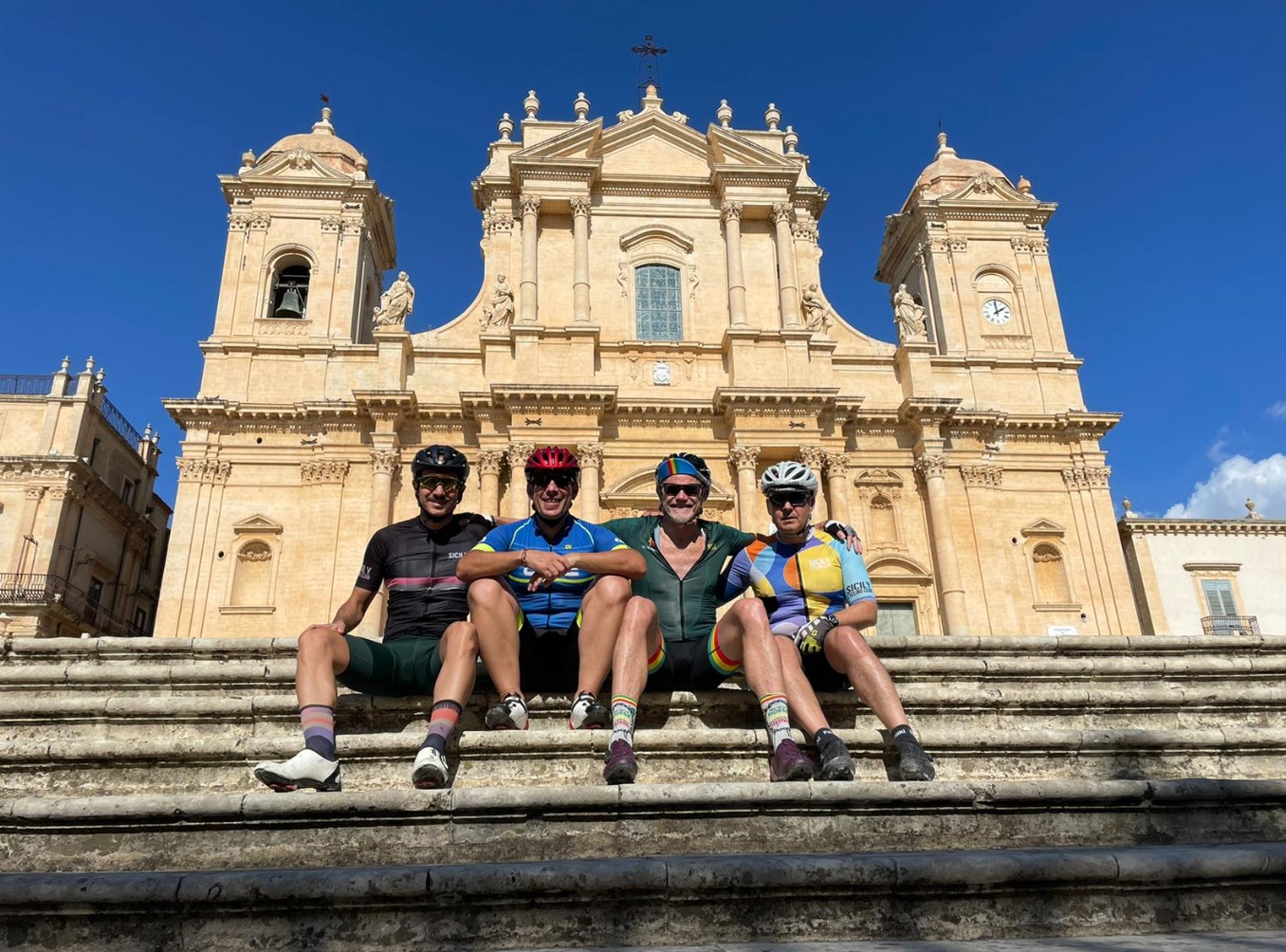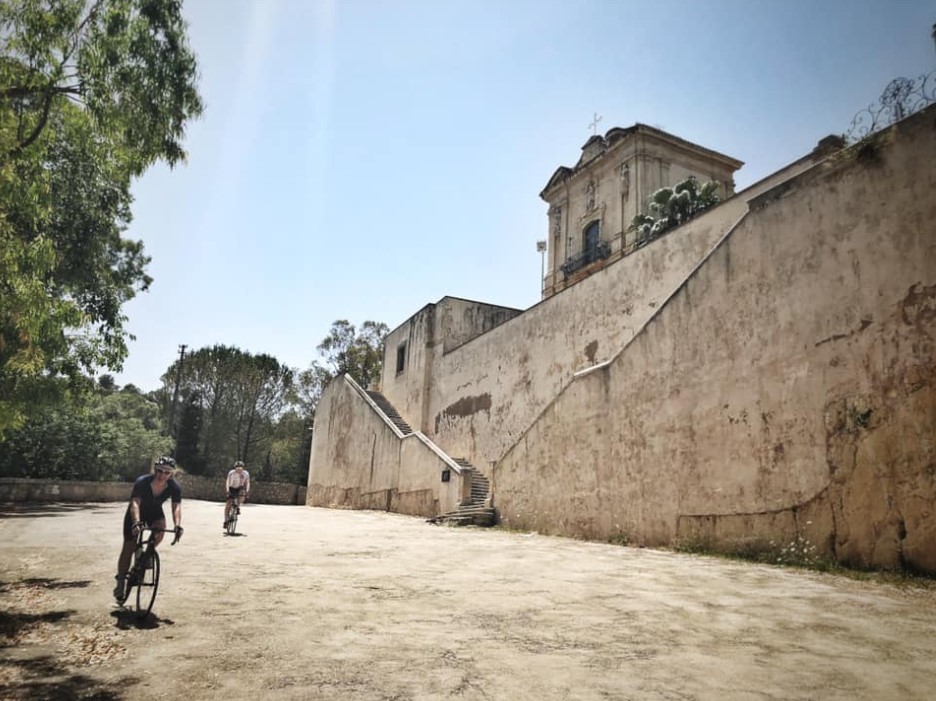The area of Noto is one of the most famous around the world for its beautiful Baroque Style. This kind of architecture perfectly represents Sicilians. We are always too much. We talk a lot, eat a lot, we talk too loud, like decorations with a lot of colors. That’s what we are.

105 km 1,060 hm
Download the route here
The area of the Val di Noto is not flat at all. Cassibile river, over the centuries, dug a huge canyon. We like to ride along the canyon, visit the old ruins, watch the beach from the top, and, in the end, visit one of the most beautiful beaches of Sicily: the Gelsomineto Beach (or Spiaggia della Marchesa).
The ride can start in Siracusa or in Avola. If you start in Siracusa you’ll have the possibility to warm up a bit on the flat, otherwise, you have to climb from km 0.
If you start in Siracusa you must first visit Ortigia or we don’t want to deal with you anymore! That’s an offer you can’t refuse! Ortigia, and the Duomo Square, in particular, is one of the most incredible places you can see in Sicily. The square is very white like Siracusa because of the use of the “White Stone of Siracusa” mostly composed of limestone. Sicilians call that stone “Pietra Giuggiulena”.
After a cafe at the Bar, you are ready to start. Oh, one thing about the “Bar” word in Italian. We are not crazy. We don’t start our day drinking whiskey. In Italian, we use the word Bar as Americans use “Cafe”.
So if one of Sicily Cycling Club guides says: “Let’s stop at the Bar!” is just because wants to offer you a coffee, not a Jack Daniel’s!
Ok, time to ride! Wait a minute… before we start the ride we HAVE to stop at the “Fonte Aretusa”. People from Siracusa are also called Aretusei. Do you know why? Well is one of the greek myths that you will learn in Sicily. Basically, Aretusa was a beautiful girl that was turned into a river by Artemide, goddess of Virginity, to let her escape from Alfeo, son of the Titan Oceano. Zeus, moved by Alfeo’s pain, then turned him into a river to let him join her. This myth also represents the connection between Sicily and Greek.
Ok, we go south after the bridge that connects Ortigia to the land towards Fontane Bianche. This is the place where Aretusei go to the beach. After 25km we reach Avola. It’s now time for the first climb.
The climb up to Avola Antica is about 8km with 400 hm. The view from the top is spectacular. Along the road, you can see some holes in the rock. These, about 1000 years b.c. were tombs and recently (even today) were used as shelters by the shepherds.
After the climb to Avola, you will reach Cavagrande del Cassibile. Here from the top, you have the most amazing view of the Laghetti di Cavagrande.
There is a sign and a barrier here saying that you are not allowed to walk to the Lakes. Actually, there is also a wooden box that helps you to pass the barrier by stepping on it. So you cannot do it but everyone does! The place is really impressive. Everywhere else in the world you would see Tourists and Guides to help you enjoy the area. But we are in Sicily. Sometimes we just don’t understand how lucky we are. That’s one of the Sicilians’ contradictions. We complain we don’t have a good economy but we don’t take advantage of what we were gifted by mother nature.
BTW, we have shoes with cleats. We cannot walk down the Lakes (it would take 45 mins). We want to ride more and more. After about 5km of easy descent, we reach the “Santuario di Santa Maria della Scala” an XVII-century convent. Here, on the side of the road, there is a door with a stair to get very good water from a historic fountain because the last climb of the day will start after the incredible ruins of Noto Antica just 3 km ahead.
Noto Antica’s name was Netum. This greek and roman town was built below mount Alveria and was completely destroyed by the biggest earthquake in Italian history back in 1693. Almost 60.000 people died in Sicily because of the earthquake which destroyed also Catania. You can leave your bike right after the gate of the city and walk around. There is also a map of the city before its destruction.
After the stop in Noto Antica you start the climb to Testa dell’Acqua passing through the area of the Pineta (Pine trees forest). The climb is about 6km and 300hm. Nothing crazy. The tarmac is ok and you will love all the white stone walls on the side. We call “Muri a secco” and they are all over the countryside in this area and all the area of Ragusa.
When you reach Testa dell’Acqua you can say that the hard part is over. There will be no more climbing but, there is still a lot to see. In fact, it is time to visit one of the most precious gems of Sicily: the city of Noto.
The “modern“ Noto was occupied after Noto Antica was destroyed. Back in 2002, Noto was been declared Unesco World Heritage Site for its incredible Baroque architecture. Cycling through the main road, Corso Vittorio Emanuele, you will see the Cathedral, the Town Hall, and the Hercules’ Fountain.
Have you watched the “Chef’s Table” Netflix Series episode on Corrado Assenza and Cafe Sicilia? Corrado is the most famous pastry chef in Italy. Tasting the “Schiumone”, the Granita, and all the other incredible dishes is an experience you will never forget! The good news is that you have already burned many calories so you can eat all you want!
Your cycling day is almost over! Just a few kilometers on the flat back to the start (Siracusa or Avola). We are sure you will remember this 100 km on the bike for the rest of your life.
Do you want to get the best from your cycling day? Request a Guide!
Do you need a bike?
Anything else? Contact us here!







